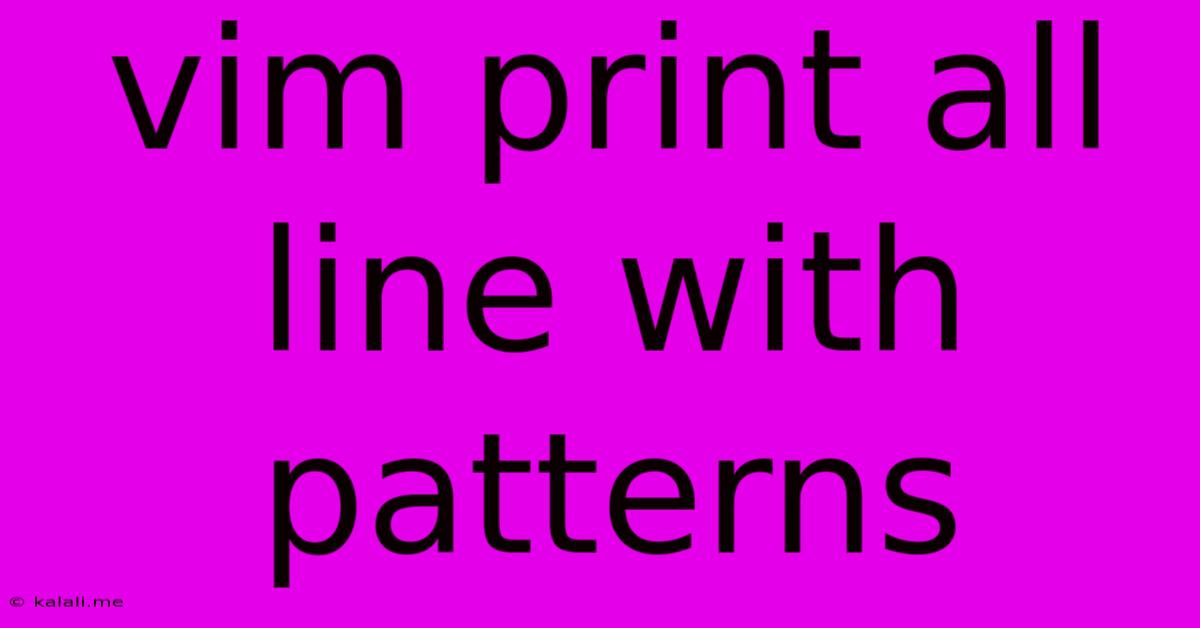Vim Print All Line With Patterns
Kalali
May 24, 2025 · 3 min read

Table of Contents
Vim: Printing Lines Matching Specific Patterns
Finding and displaying lines containing specific patterns within a large file is a common task for any developer or text editor user. Vim, a powerful text editor, offers several efficient ways to achieve this, far surpassing simple search functionalities. This article will guide you through various Vim commands to print all lines matching particular patterns, catering to different levels of complexity and user preference.
Understanding the Core Commands:
The foundation of our approach lies in Vim's search capabilities combined with its powerful line-oriented commands. We'll primarily leverage the / (forward search) or ? (backward search) commands along with the :g (global) command.
Method 1: Using / and n for Simple Pattern Matching
For straightforward searches, the simplest method involves using the /pattern command to locate the first occurrence of your pattern. Then, repeatedly press n to navigate to subsequent lines containing the same pattern. This method is great for smaller files or quickly scanning for a few instances.
Method 2: The Powerful :g (Global) Command
The :g command is where Vim’s true power shines. It allows you to execute a command on all lines matching a pattern. To print all lines containing a specific pattern, use the following syntax:
:g/pattern/p
:ginitiates the global command./pattern/specifies the regular expression you are searching for. Remember to escape special characters like.or*appropriately.pprints the lines that match the pattern.
For example, to print all lines containing the word "error" in a file, you would use:
:g/error/p
This concise command offers a significant advantage over manually searching and navigating through each line.
Method 3: Refining Searches with Regular Expressions
Vim's support for regular expressions elevates the search capabilities significantly. This allows for more sophisticated pattern matching, going beyond simple keyword searches. For example:
- To find lines containing numbers:
:g/[0-9]/p - To find lines starting with "function":
:g/^function/p - To find lines ending with ".txt":
:g/\.txt$/p
Remember to consult Vim's regular expression documentation for a comprehensive understanding of available metacharacters and operators.
Method 4: Combining :g with Other Commands
The flexibility of :g extends beyond simply printing lines. You can combine it with other commands to perform actions on matching lines. For instance:
:g/pattern/ddeletes lines containing the pattern.:g/pattern/yankyanks (copies) matching lines into the system clipboard.:g/pattern/s/old/new/gsubstitutes "old" with "new" on all matching lines.
Method 5: Using Visual Mode for Interactive Selection
For a more interactive approach, use Vim's visual mode. Press v to enter visual mode, then navigate to the beginning of the line containing your target pattern. Press SHIFT+G to highlight all subsequent lines containing the pattern. Then you can copy (y) or delete (d) or perform other actions. This offers excellent visual control.
Conclusion:
Vim's capabilities for managing and manipulating lines based on patterns are truly remarkable. Whether you need a quick scan for a specific keyword or complex regular expression-based operations, mastering the techniques described above will significantly enhance your workflow and efficiency when dealing with text files in Vim. Experiment with different combinations of commands and regular expressions to tailor your approach to the specifics of your task. Remember to always save your work before performing potentially destructive operations like deleting lines using :g/pattern/d.
Latest Posts
Latest Posts
-
How Many Cups Is 1 Pound Of Cheese
Jul 12, 2025
-
30 X 30 Is How Many Square Feet
Jul 12, 2025
-
How Much Does A Half Oz Weigh
Jul 12, 2025
-
Calories In An Omelette With 3 Eggs
Jul 12, 2025
-
How Do You Say Great Grandmother In Spanish
Jul 12, 2025
Related Post
Thank you for visiting our website which covers about Vim Print All Line With Patterns . We hope the information provided has been useful to you. Feel free to contact us if you have any questions or need further assistance. See you next time and don't miss to bookmark.